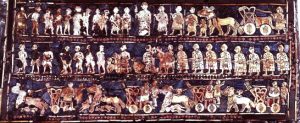Join us for conversations that inspire, recognize, and encourage innovation and best practices in the education profession.
Available on Apple Podcasts, Spotify, Google Podcasts, and more.

The world of Gilgamesh in the context of the contemporary Middle East.
© 2010 Map Resources, All rights reserved.
This map shows the world of Gilgamesh: his home city-kingdom, Uruk, is just northwest of today’s Iraqi city of Basra, on the Euphrates River, near the Persian Gulf and the border with today’s Iran. This was the heart of the Fertile Crescent, where the first great human civilization arose around 8000 BCE. While southern Iraq is mostly desert today, in the time of Gilgamesh (around 2800 BCE), it was wetter and greener, an agricultural center fed by its two rivers.

The earliest city states of Sumer are established.

The real Gilgamesh becomes king.

Early Sumerian literature appears and the real Gilgamesh is deified in the gods list.
The real Gilgamesh is worshipped in cults.

The advent of the Old Akkadian Empire occurs when King Sargon conquers Sumer. Akkadian emerges as the language of empire and later becomes one of the written languages of the story of Gilgamesh.

The oldest known copy of a Sumerian Gilgamesh poem dates from 2100.
The fall of Ur occurs and spoken Sumerian dies out.

The Old Babylonian Gilgamesh epic is written by an unknown person between 1800-1600 BCE.

Babylon is sacked by the Hittites.
Copies are made of the Middle Babylonian versions of Gilgamesh epic “Surpassing all other kings.”
Organizing and editing of Babylonian literature, including the Gilgamesh story takes place. Sin-liqe-unninni edits “Surpassing all other Kings” and other materials into the Akkadian-language epic “He who saw the deep.”

The Assyrians overthrow the Hittites.

King Ashurbanipal takes the throne at Nineveh. Sin-liqe-unninni’s version of the epic is copied for Ashurbanipal.

Nineveh falls following the death of King Ashurbanipal and spoken Akkadian is dying out.

Babylonian literature is copied out and preserved in libraries of temples and scholars. The last cuneiform tablets are written. Scribes use the Gilgamesh stories for practice, and archeological research has relied on these copies to help reconstruct the story of the text.
The story of Gilgamesh is lost when the tablets it is written on are dispersed and buried in many regions of the Near East.

Archeologists find tablets of the Gilgamesh epic in various sites, including the ruins of Ashurbanipal’s palace in Nineveh. The tablets, which the archaeologists could not read, were deposited at the British Museum in London.

Amateur Assyriologist George Smith deciphers the tablets at the British Museum relating Utnapishtim’s story of the flood. Smith’s work becomes front-page news, and Gilgamesh begins a new life claiming its role as the first story of World Literature.

Gilgamesh is compiled, translated, and published in many editions and languages. Continuing archeological and textual research improve the text.